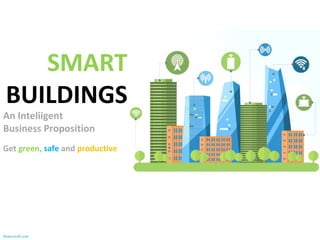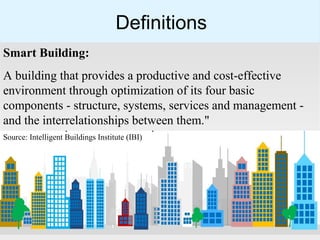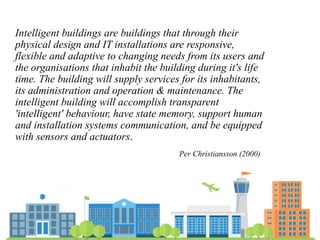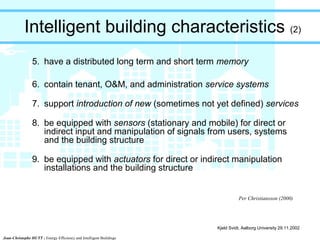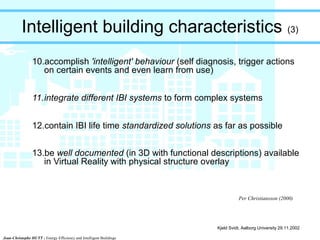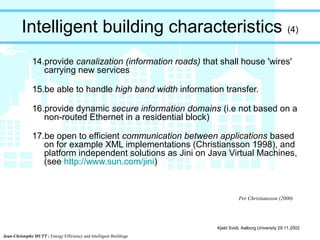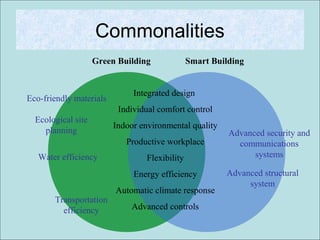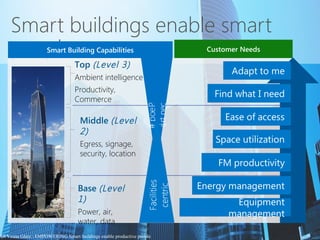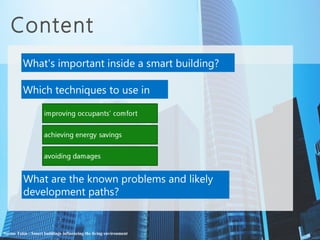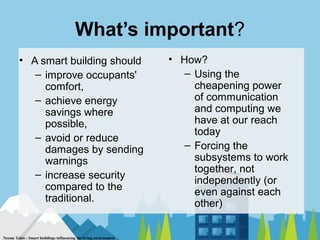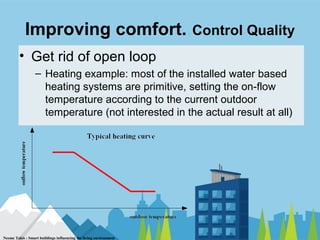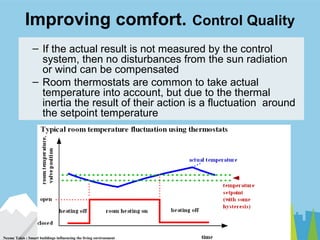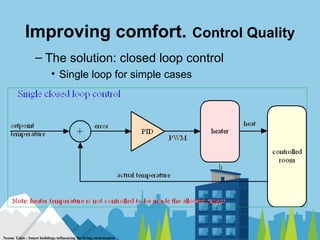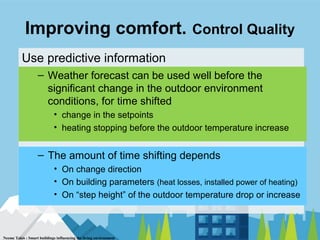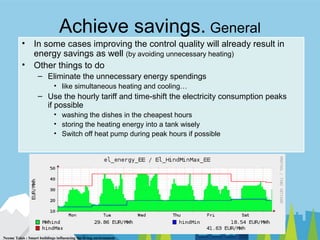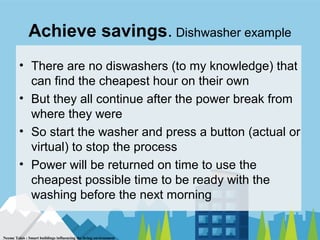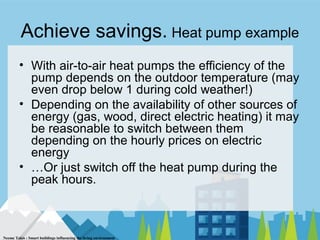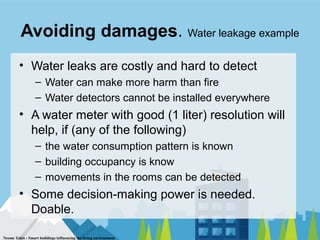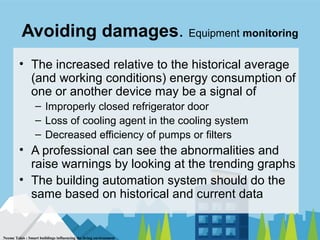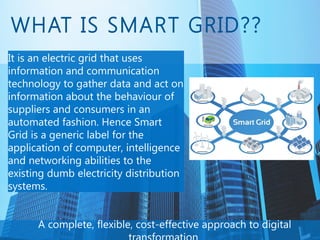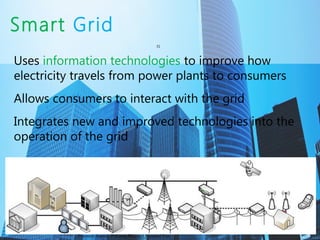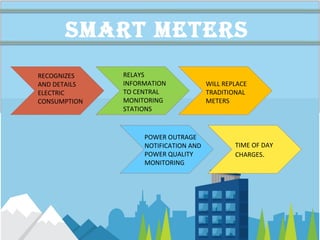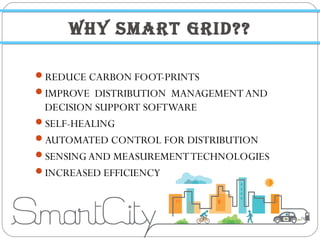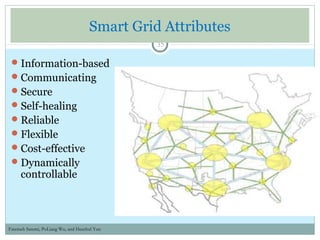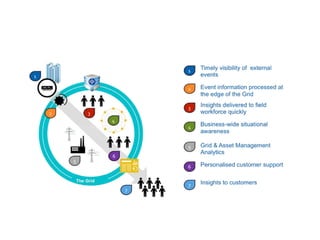Summary of smart building
- 1. Honeywell.com SMART BUILDINGS An Inteliigent Business Proposition Get green, safe and productive
- 2. What is an intelligent building? A building… • who’s systems are self reliant • with sensors relaying data • that uses the latest technology • that is the future of buildings Anthony Piscielli : Intelligent Building
- 3. Definitions Smart Building: A building that provides a productive and cost-effective environment through optimization of its four basic components - structure, systems, services and management - and the interrelationships between them." Source: Intelligent Buildings Institute (IBI)
- 4. Kjeld Svidt, Aalborg University 29.11.2002 Intelligent buildings are buildings that through their physical design and IT installations are responsive, flexible and adaptive to changing needs from its users and the organisations that inhabit the building during it's life time. The building will supply services for its inhabitants, its administration and operation & maintenance. The intelligent building will accomplish transparent 'intelligent' behaviour, have state memory, support human and installation systems communication, and be equipped with sensors and actuators. Per Christiansson (2000) Jean-Christophe HUTT : Energy Efficiency and Intelligent Buildings
- 5. Smart Buildings • Many new buildings are being built with complex building automation systems • Sensors and control systems create rich information streams • Access to these streams is restricted • This information could be useful to building users as well as administrators Jodie P. Boyer, Kaijun Tan, Carl A. Gunter : Privacy Sensitive Location Information Systems in Smart Buildings
- 6. Source: Technology Roadmap for Intelligent Buildings (http://www.caba.org/trm) Ron Zimmer, Intelligent Buildings - Meter Reading and Energy Management Definition of Intelligent Building Technologies “ The use of integrated technological building systems, communications and controls to create a building and its infrastructure which provides the owner, operator and occupant with an environment which is flexible, effective, comfortable and secure.”
- 7. Kjeld Svidt, Aalborg University 29.11.2002 Intelligent building characteristics (1) 1. be flexible and responsive to different usage and environmental contexts such as office, home, hotel, and industry invoking different kinds of loads from nature, people, and building systems, 2. be able to change states (clearly defined) with respect to functions and user demands over time and building spaces (easy to program and re-program during use) 3. support human communication (between individuals and groups) 4. provide transparent intelligence and be simple and understandable to the users (support ubiquitous computers and networks) Per Christiansson (2000) Jean-Christophe HUTT : Energy Efficiency and Intelligent Buildings
- 8. Kjeld Svidt, Aalborg University 29.11.2002 Intelligent building characteristics (2) 5. have a distributed long term and short term memory 6. contain tenant, O&M, and administration service systems 7. support introduction of new (sometimes not yet defined) services 8. be equipped with sensors (stationary and mobile) for direct or indirect input and manipulation of signals from users, systems and the building structure 9. be equipped with actuators for direct or indirect manipulation installations and the building structure Per Christiansson (2000) Jean-Christophe HUTT : Energy Efficiency and Intelligent Buildings
- 9. Kjeld Svidt, Aalborg University 29.11.2002 Intelligent building characteristics (2) 5. have a distributed long term and short term memory 6. contain tenant, O&M, and administration service systems 7. support introduction of new (sometimes not yet defined) services 8. be equipped with sensors (stationary and mobile) for direct or indirect input and manipulation of signals from users, systems and the building structure 9. be equipped with actuators for direct or indirect manipulation installations and the building structure Per Christiansson (2000) Jean-Christophe HUTT : Energy Efficiency and Intelligent Buildings
- 10. Kjeld Svidt, Aalborg University 29.11.2002 Intelligent building characteristics (2) 5. have a distributed long term and short term memory 6. contain tenant, O&M, and administration service systems 7. support introduction of new (sometimes not yet defined) services 8. be equipped with sensors (stationary and mobile) for direct or indirect input and manipulation of signals from users, systems and the building structure 9. be equipped with actuators for direct or indirect manipulation installations and the building structure Per Christiansson (2000) Jean-Christophe HUTT : Energy Efficiency and Intelligent Buildings
- 11. Kjeld Svidt, Aalborg University 29.11.2002 Intelligent building characteristics (3) 10.accomplish 'intelligent' behaviour (self diagnosis, trigger actions on certain events and even learn from use) 11.integrate different IBI systems to form complex systems 12.contain IBI life time standardized solutions as far as possible 13.be well documented (in 3D with functional descriptions) available in Virtual Reality with physical structure overlay Per Christiansson (2000) Jean-Christophe HUTT : Energy Efficiency and Intelligent Buildings
- 12. Kjeld Svidt, Aalborg University 29.11.2002 Intelligent building characteristics (4) 14.provide canalization (information roads) that shall house 'wires' carrying new services 15.be able to handle high band width information transfer. 16.provide dynamic secure information domains (i.e not based on a non-routed Ethernet in a residential block) 17.be open to efficient communication between applications based on for example XML implementations (Christiansson 1998), and platform independent solutions as Jini on Java Virtual Machines, (see http://www.sun.com/jini) Per Christiansson (2000) Jean-Christophe HUTT : Energy Efficiency and Intelligent Buildings
- 13. Commonalities Green Building Smart Building Integrated design Individual comfort control Indoor environmental quality Productive workplace Flexibility Energy efficiency Automatic climate response Advanced controls Eco-friendly materials Advanced security and communications systems Advanced structural system Water efficiency Ecological site planning Transportation efficiency
- 14. Smarter Building - Potential Business Benefits Physical buildings and assets • Identify/exploit strategic property opportunities. • Avoid costly property holdings • Drive space utilisation using technology • Improve comfort and employee efficiency • Automate corporate environmental reporting • Energy and carbon monitoring & management • Asset Management • Reduce redundant assets • Improve projects for efficiency • Optimise maintenance activity • Lower building operation costs • Streamline operational processes • Share services and data across the portfolio • Collection of building control information • Lower risk of significant failures • Building operations stable safe and secure • Physical & logical security and control Strategic savings 10%-20% savings 10%-30% savings 10%-20% savings Vital enabling measurement Less downtime Potential business benefits Smarter Inter- connected Instrumented Intelligent Smarter Inter- connected Instrumented Intelligent
- 15. 15 Smart buildings enable smart people Top (Level 3) Ambient intelligence Productivity, Commerce Middle (Level 2) Egress, signage, security, location Base (Level 1) Power, air, water, data People centric Smart Building Capabilities Customer Needs DI Vesna Glatz : EMPOWERING Smart buildings enable productive people
- 16. 16 Content What are the known problems and likely development paths? Which techniques to use in What's important inside a smart building? Neeme Takis : Smart buildings influencing the living environment
- 17. What’s important? • A smart building should – improve occupants' comfort, – achieve energy savings where possible, – avoid or reduce damages by sending warnings – increase security compared to the traditional. Neeme Takis : Smart buildings influencing the living environment • How? – Using the cheapening power of communication and computing we have at our reach today – Forcing the subsystems to work together, not independently (or even against each other)
- 18. Improving comfort. Control Quality • Get rid of open loop – Heating example: most of the installed water based heating systems are primitive, setting the on-flow temperature according to the current outdoor temperature (not interested in the actual result at all) Neeme Takis : Smart buildings influencing the living environment
- 19. Improving comfort. Control Quality – If the actual result is not measured by the control system, then no disturbances from the sun radiation or wind can be compensated – Room thermostats are common to take actual temperature into account, but due to the thermal inertia the result of their action is a fluctuation around the setpoint temperature Neeme Takis : Smart buildings influencing the living environment
- 20. Improving comfort. Control Quality – The solution: closed loop control • Single loop for simple cases Neeme Takis : Smart buildings influencing the living environment
- 21. Improving comfort. Control Quality • Cascaded loops for real life (with limit settings) Neeme Takis : Smart buildings influencing the living environment
- 22. Improving comfort. Control Quality – The amount of time shifting depends • On change direction • On building parameters (heat losses, installed power of heating) • On “step height” of the outdoor temperature drop or increase Neeme Takis : Smart buildings influencing the living environment – Weather forecast can be used well before the significant change in the outdoor environment conditions, for time shifted • change in the setpoints • heating stopping before the outdoor temperature increase Use predictive information
- 23. Achieve savings. General • In some cases improving the control quality will already result in energy savings as well (by avoiding unnecessary heating) • Other things to do – Eliminate the unnecessary energy spendings • like simultaneous heating and cooling… – Use the hourly tariff and time-shift the electricity consumption peaks if possible • washing the dishes in the cheapest hours • storing the heating energy into a tank wisely • Switch off heat pump during peak hours if possible Neeme Takis : Smart buildings influencing the living environment
- 24. Achieve savings. Dishwasher example • There are no diswashers (to my knowledge) that can find the cheapest hour on their own • But they all continue after the power break from where they were • So start the washer and press a button (actual or virtual) to stop the process • Power will be returned on time to use the cheapest possible time to be ready with the washing before the next morning Neeme Takis : Smart buildings influencing the living environment
- 25. Achieve savings. Heat pump example • With air-to-air heat pumps the efficiency of the pump depends on the outdoor temperature (may even drop below 1 during cold weather!) • Depending on the availability of other sources of energy (gas, wood, direct electric heating) it may be reasonable to switch between them depending on the hourly prices on electric energy • …Or just switch off the heat pump during the peak hours. Neeme Takis : Smart buildings influencing the living environment
- 26. Achieve savings. Direct heating example • If a storage tank is in use for nightly heating, replace the primitive day/night tariff switching or simple timer based control with a price-aware solution • Estimating how much heat energy is needed next day, charge the tank with heat energy during the cheapest hours • Charge to the needed level only (not more) Neeme Takis : Smart buildings influencing the living environment
- 27. Avoiding damages. Water leakage example • Water leaks are costly and hard to detect – Water can make more harm than fire – Water detectors cannot be installed everywhere • A water meter with good (1 liter) resolution will help, if (any of the following) – the water consumption pattern is known – building occupancy is know – movements in the rooms can be detected • Some decision-making power is needed. Doable. Neeme Takis : Smart buildings influencing the living environment
- 28. Avoiding damages. Equipment monitoring • The increased relative to the historical average (and working conditions) energy consumption of one or another device may be a signal of – Improperly closed refrigerator door – Loss of cooling agent in the cooling system – Decreased efficiency of pumps or filters • A professional can see the abnormalities and raise warnings by looking at the trending graphs • The building automation system should do the same based on historical and current data Neeme Takis : Smart buildings influencing the living environment
- 29. Smart Cities segments at Schneider Electric
- 30. WHAT IS SMART GRID?? A complete, flexible, cost-effective approach to digital It is an electric grid that uses information and communication technology to gather data and act on information about the behaviour of suppliers and consumers in an automated fashion. Hence Smart Grid is a generic label for the application of computer, intelligence and networking abilities to the existing dumb electricity distribution systems.
- 31. 31 Smart Grid Uses information technologies to improve how electricity travels from power plants to consumers Allows consumers to interact with the grid Integrates new and improved technologies into the operation of the grid Fatemeh Saremi, PoLiang Wu, and Heechul Yun
- 32. SMART GRID COMPONENTS DISTRIBUTED GENERATION INFORMATION TRANSFER PHASOR MEASUREMENT SMART METER
- 33. POWER OUTRAGE NOTIFICATION AND POWER QUALITY MONITORING SMART METERS RECOGNIZES AND DETAILS ELECTRIC CONSUMPTION RELAYS INFORMATION TO CENTRAL MONITORING STATIONS WILL REPLACE TRADITIONAL METERS TIME OF DAY CHARGES.
- 34. WHY SMART GRID?? REDUCE CARBON FOOT-PRINTS IMPROVE DISTRIBUTION MANAGEMENT AND DECISION SUPPORT SOFTWARE SELF-HEALING AUTOMATED CONTROL FOR DISTRIBUTION SENSING AND MEASUREMENTTECHNOLOGIES INCREASED EFFICIENCY
- 35. 35 Smart Grid Attributes Information-based Communicating Secure Self-healing Reliable Flexible Cost-effective Dynamically controllable Fatemeh Saremi, PoLiang Wu, and Heechul Yun
- 36. EX Smart Grid CLP
Editor's Notes
- Cite image location
- Key Points: Talk about capabilities. As all architects know a building has a base, a middle & a head…..you should think of evolution of smart building tech in same way Base – the building elements - power, water, data, air and the systems that use these, chillers, HVAC, Heating, Lighting, etc. Middle....egress, signage, elevators, security, parking Top – ambient intelligence…space knows who you are, what you want to do. Customers here are tenants, FM managers, Property owners, Residents MSFT Playing in all 3 layers and all parts of the lifecycle…and with customers. FM they are trying to drive cost savings Tenants want convenience and productivity Takeaway. Building systems and Data are required to unlock most of the productivity scenarios.
- Key Points: Talk about capabilities. As all architects know a building has a base, a middle & a head…..you should think of evolution of smart building tech in same way Base – the building elements - power, water, data, air and the systems that use these, chillers, HVAC, Heating, Lighting, etc. Middle....egress, signage, elevators, security, parking Top – ambient intelligence…space knows who you are, what you want to do. Customers here are tenants, FM managers, Property owners, Residents MSFT Playing in all 3 layers and all parts of the lifecycle…and with customers. FM they are trying to drive cost savings Tenants want convenience and productivity Takeaway. Building systems and Data are required to unlock most of the productivity scenarios.
- The audio, video, lighting scene related aspects of smart living have never really interested me. For me the health and optimal operation of technical systems has always been the important thing. Unlike with music and video, or voice command to the curtains, here the automation outperforms a human. It is time to put the systems work together.
- Absolute majority of heating control systems are simple or even primitive. They are not really interested on the end result. Their interest is on providing hor water with temperature inversely proportional to the outdoor temperature.
- The cure is to add thermostats, woks well enough with radiators, but not with heated floor, having a remarkable thermal inertia. Thing is the floor surface continues to heat up for some hours after the flow of warm water is closed. And it continues to cool down for for a while after the water flow is opened again.
- Weather forecast are a good thing to fight with the effects of thermal inertia. It allows to start or stop heating a calculated number number of hours before the outdoor temperature change takes place. That time of looking into the future is different for the outdoor temperature drop of increase, because the stored heat energy leaves the building slower than arrives. THe heat energy leaves via insulation and ventilation, but can arrives by the full power of the heating system.
- Key points: Microsoft has the end-to-end platform for smart buildings. Flexible and modular solution. Take iterative approach to reduce implementation time and minimize costs. [click to build slide] Let me tell you what the platform means.
- Key points: Microsoft has the end-to-end platform for smart buildings. Flexible and modular solution. Take iterative approach to reduce implementation time and minimize costs. [click to build slide] Let me tell you what the platform means.
- Slide 10: Why health organizations need IoT Key Points: Getting started on the Internet of Things NOW will enable you to transform your health organization IoT helps health providers build smarter operations, improve patient care, increase business agility, and gain better insights Talk Track: Once you get past all the confusion and noise and realize just how simple and powerful IoT can be, the next question becomes, “What can it do for my health organization? Why does it matter?” Let’s go through the chief reasons: Build smarter operations Implement preventative and predictive maintenance on medical devices to eliminate machine down-time and reduce costs. Monitor and manage hospital infrastructure to optimize energy consumption and reduce maintenance costs. Track the location of devices and supplies in real time to ensure the right supplies are always in the right location and reduce paper trace. Improve patient care Track patient health conditions in real time regardless of the patient’s physical location to improve care quality and outcomes. Track patient’s response to therapy and drugs in real time and monitor when a patient takes prescribed pills, allowing providers to take preventative actions and better manage chronic conditions. Remote health monitoring enables better access to medical services for more people, like people living in remote areas or elderly people. Provide better patient experiences with interactive targeted device experiences. Increase business agility Enhance operational performance management with better, faster insights. Real-time data insights can help providers respond more quickly to patient needs and population health management. Accelerate innovation internally and externally with insights shared across functions and partners. Implement new ideas and scale easily using cloud-based solutions without heavy capital investment. Gain better insights Gain real-time operational insight to run your healthcare business with more efficiency and intelligence. Gain real-time insights through continuously monitoring patient health conditions and behaviors to drive more timely and personalized care and improve outcomes. Use predictive analytics to identify patterns and predict trends to improve patient care outcomes and reduce costs.
